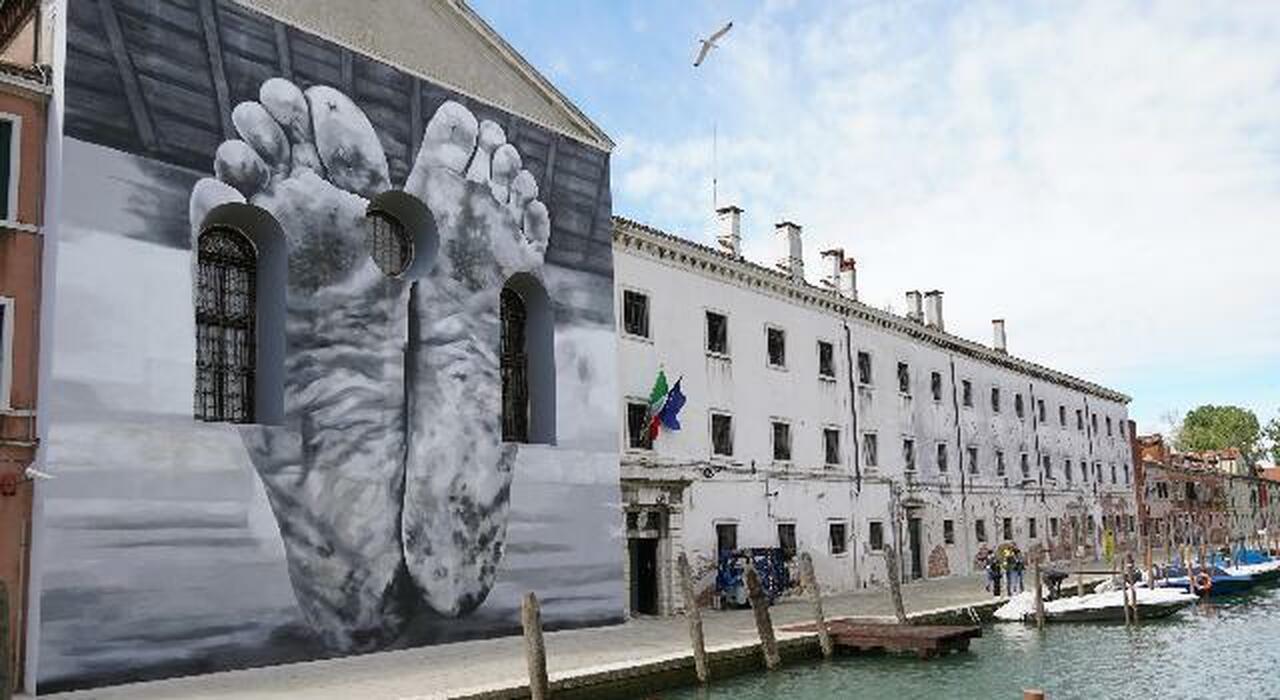Sunday 28 April 2024, 08:37 - Last updated: 11:39
VENICE The only thing the Pope will not have to do is to deposit his cellphone under the watchful eyes of prison guards, nor be subjected to a metal detector check before crossing the gate. Otherwise, his visit to the Pavilion for the Biennale of Art - set up inside the Giudecca women's prison - will be exactly like that of ordinary visitors who want to see with their own eyes what the leading exponents of contemporary art have created by working for months, elbow to elbow, with the inmates themselves. It begins with a tortuous path, amidst corridors, walls eight meters high, suffocating, topped by barbed wire, towers. Time marked by the noise of heavy bunches of keys clanging against each other and by the thuds of armored doors behind. Once it was a monastery of the 'converted', now it is a place of detention for about eighty guests, some of whom are sentenced to the maximum penalty.
Minister Nordio inaugurates the Vatican Pavilion at the Venice Biennale: 'art offers hope in places of pain'
POETRY
'I am in a place I would never want to be, but I have learned a lot. I live for my son, the dearest thing in my life. Life is precious, it must be lived through good and bad. A beautiful thought for everyone,' writes Alessandra in this poem composed for the Biennale. Three inmates act as guides to the international group of journalists who were able to experience the papal route in advance, on the eve of the trip to Venice. Antonella, Fanta, and Giulia introduce themselves and welcome. They wear a black and white coat, sewn by themselves in the internal workshop. They lead the guests, revealing step by step the symbolism enclosed in the works they encounter. They immediately show us the cafeteria, their meeting place. 'This is an environment where we work. On that wall are the works of Corita Kent, an American artist, political activist far ahead of her times.' Fanta speaks in English adding more details about the forerunner of pop art. She points to a colorful poster, in huge letters: HOPE even though it is written backwards. 'Among all the artists on display, this is the only one who has been gone for a long time.' Giulia, with long black hair, a nose piercing, very intense eyes, states: 'her message emanates color even to us, in a place where color does not exist.'
Biennale, Cattelan at the Vatican Pavilion where visitors are accompanied in the Venetian Giudecca by the inmates
Most likely it will be Antonella, Fanta, and Giulia themselves who will act as guides for Pope Francis, discovering the meaning of the works signed by Claire Taburè, Simone Fattal, Claire Fontaine, Maurizio Cattelan, Marco Perego and Zoe Saldana, Sonia Gomes, Bintou Deambula. The creators of the Pavilion, Chiara Parisi and Bruno Racine, will also be there, true engines of the idea together with Cardinal José Tolentino de Mendonca.
ARTISTIC SOUL
Giulia is shy but perhaps, judging by the poems she has composed and which have been used by Simone Fattal to create glazed lava plaques along the perimeter of the boundary wall, she is the artistic soul of the group. Overlapping signs and calligraphies mixed that speak of anger, added to joy, tears, freedom. At the bottom of that boundary wall there is the wide-eyed gaze of the collective Claire Fontaine. At night, when everything is wrapped in darkness, it lights up in blue. 'It indicates a blindness that goes beyond visual capacity,' emphasizes Alessandra. The work is inspired by the title of the Pavilion, 'With my eyes', a comparison between those who are free as air and those who only have air for a couple of hours a day in the inner courtyard topped by another installation that lights up in the dark and announces: 'We are with you in the night.' Practically two worlds that the Holy See wanted to bring closer not to absolve, but to understand, each with its own gaze. 'If we look out of those windows at night we see it.' Although the Vatican Pavilion that opened its doors a few days ago - in fact will symbolically inaugurate a path that caresses the idea of transforming the hearts of visitors. 'It is the hope that moved us,' whispers Chiara Parisi.
THE DAY
Francesco will meet the inmates in the deconsecrated chapel of the prison where, as in a play of mirrors, colored filaments of fabrics are hung from the ceiling. 'I like to imagine that they are cocoons that are transforming and then will fly away like butterflies,' smiles Giulia. To the artists, Francesco will address important words, after all, art has the imaginative power to reflect on the future and break through every barrier. The program of his Venetian day, all six very intense hours - includes a meeting with young people, followed by mass in San Marco square. It is clear that it will be a sort of test on his health after the troubles that have tormented him in recent months. The papal visit, however, also hides controversial aftermaths, such as the fact of charging pilgrims the famous tourist access fee, 5 euros each for a total of nine thousand paying out of 10 thousand faithful, something that has turned up the noses of many Catholics.
© ALL RIGHTS RESERVED
This article is automatically translated
